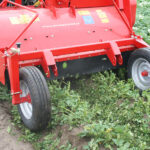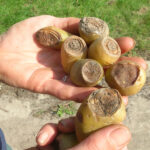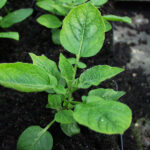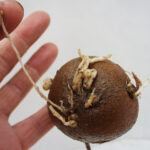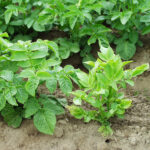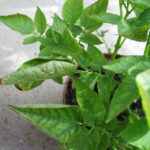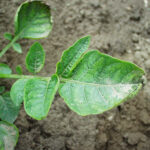Polish name: Wirus liściozwoju
English name: Potato leafroll virus, PLRV
Kod EPPO: PLRV00
Gallery
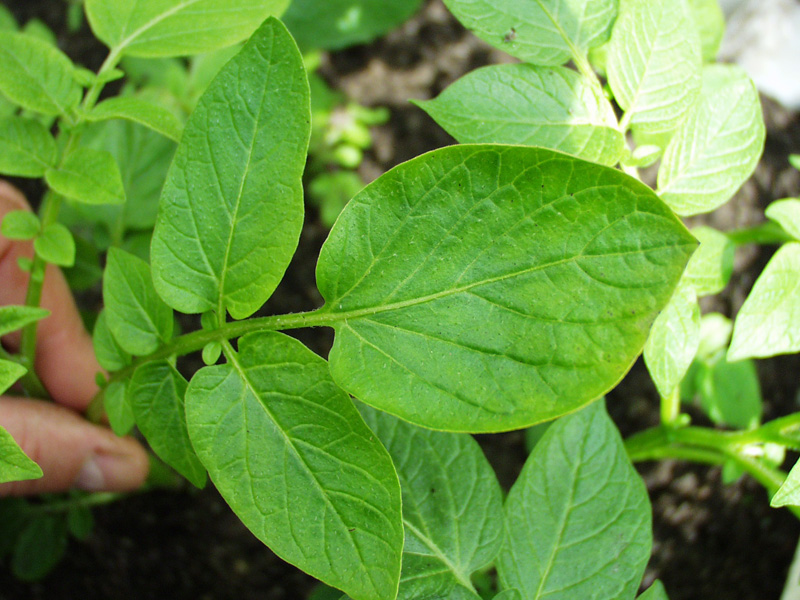
Weak mosaics on potato leaves
(Photo: S. Wróbel)
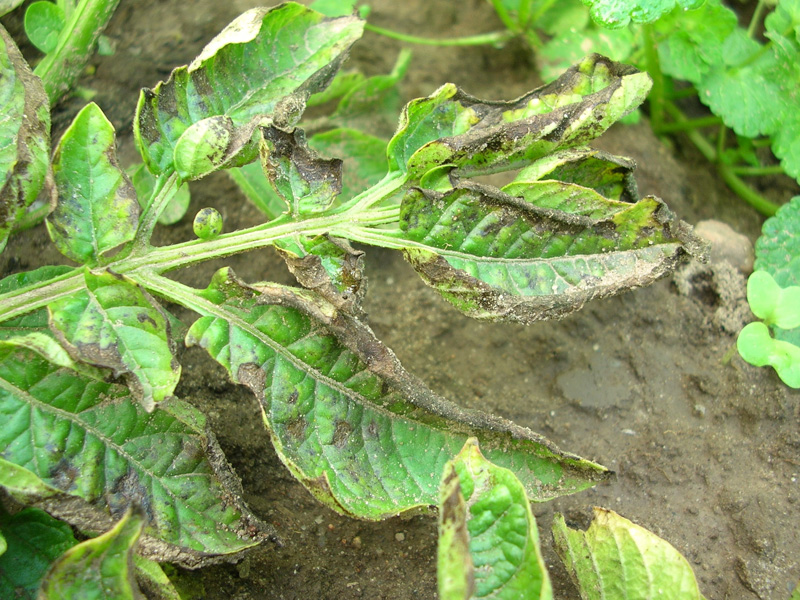
Necrosis of the lower leaf margins
(Photo: S. Wróbel)

Stunted growth is a common symptom in plants infected with PLRV
(Photo: S. Wróbel)
- 2-rzędowy rozbijacz łęcin Grimme KS 75-2 (fot. S. Wróbel)
- Uszkodzenia bulw po niewłaściwym zastosowaniu środków zawierających dikwat (fot. S. Wróbel)2
- Uszkodzenia bulw po niewłaściwym zastosowaniu środków zawierających dikwat (fot. S. Wróbel)
- Objawy przypominające porażenie PLRV – na zdjęciu rośliny in vitro rozmnażane pod osłonami (fot. S. Wróbel)
- Nitkowate kiełki mogą być spowodowane porażeniem bulw PLRV (fot. S. Wróbel)
- Liście ustawione do łodygi pod kątem ostrym nadają miotlasty pokrój roślinie – jeden z symptomów porażenia PLRV (fot. S. Wróbel)
- Łyżeczkowate zwijanie się dolnych liści plus chloroza międzynerwowo (fot. S. Wróbel)
- Łyżeczkowate zwijanie się dolnych liści jest najbardziej charakterystycznym symptomem porażenia roślin ziemniaka PLRV (fot. S. Wróbel)
Characteristics and description of the disease
Potato leaf roll virus (PLRV), right after PVY, is one of the most widespread potato viruses globally. It is recorded on almost all continents, with its significance being highest in countries with mild climates. In Poland, as well as in many other European countries, the threat posed by PLRV is significantly lower than 25 years ago when it was considered one of the most dangerous viruses. Several factors contributed to this, primarily the decrease in potato cultivation area, resulting in a reduction in the number of infection sources, the introduction of many varieties with increased resistance, the elimination of PLRV from seed potato crops, and a significant reduction in the population of aphids associated with potatoes, including the main vector of PLRV – the peach-potato aphid (Myzus persicae).
Seed potatoes are the main source of PLRV infection. The virus is transmitted from infected plants to others exclusively by aphids in a persistent manner – it is a circulative virus, multiplying in the aphid’s body. After acquiring the virus from an infected plant, the aphid becomes its vector for the rest of its life. The main, and in Poland, the only practical vector of PLRV is, as mentioned earlier, Myzus persicae. Another species – the turnip-potato aphid (Aphis nasturtii) – can also transmit the virus to some extent, but its efficiency is very low, and it is only significant when the population of this aphid species is very high in the season. Unlike other viruses transmitted by aphids, effective transmission of PLRV requires a much longer time due to the need for a specific process in the aphid’s body. Although individual infections were observed in laboratory studies after 30 seconds of insect feeding, the optimal acquisition of this virus by the aphid ranges from 10 to 30 minutes. However, for the aphid to effectively infect new plants, an additional 24-48 hours must elapse. Therefore, chemical protection involving aphid control is very effective.
The harm caused by PLRV lies in a significant reduction and malformation of the yield. It can also cause defects in tubers, such as black discoloration of the flesh (so-called net necrosis). In the 1980s, this problem seriously affected farmers in the USA, mainly with the Russet Burbank variety, which at that time accounted for about 50% of the total potato cultivation area in the USA and was massively infected with PLRV. Yield losses could reach up to 80%. Legal regulations specify the maximum infection of seed potatoes with viruses for different quality classes. In Poland, the highest allowable percentage of virus-infected tubers, including PLRV, cannot exceed 10% for class B.
Symptoms of infection
PLRV is considered a severe virus in seed production. However, most registered varieties in Poland show weak to moderate symptoms after infection with this virus, making it not always easy to diagnose it under field conditions. Some resistant varieties in the field may become infected under high-temperature conditions. The most common symptoms during plant growth include:
- Lightening of leaves, slight stiffness of leaves, reduced plant vigor – often referred to as mild symptoms. In extreme cases, chlorosis of entire plants can occur.
- Spoon-shaped curling of lower leaves, growth inhibition – these are strong symptoms that occur in plants grown from infected seed potatoes. If a plant is infected with PLRV, a characteristic crack can be heard when bending a leaf with symptoms across the main vein. This is related to the callose deposition in the vascular bundles.
- Weak mosaics on leaves in shades of light green. Other colors, such as brown or yellow, are not associated with viral infection.
- Anthocyanin discoloration or necrosis of the edges of lower leaves. Leaves become stiff and leathery.
- Broom-like plant shape. Individual leaves are arranged at an acute angle to the stem, resembling a broom (hence the name).
- Some varieties (e.g., Ibis) may show an intolerance reaction to leaf roll virus, resulting in poor germination of seed potatoes or severe stunting of plants under field conditions.
- Thread-like shoots.
- Strong nitrogen fertilization promotes the masking of symptoms, while potassium increases their intensity. Symptoms resembling leaf roll, caused by physiological changes, can occur with increased turgor pressure in leaf cells. Causes may include potassium chloride fertilization, mechanical damage, infection with potato rhizoctonia, high thermal-humidity stress conditions, e.g., in a greenhouse or polytunnel. Also, infection with the M virus may be mistakenly identified by less experienced individuals as symptoms of PLRV.
Protection methods
There are no effective direct methods for controlling viruses. There are few varieties resistant to PLRV. For other varieties, the spread of this virus can only be limited. In commercial production, cultivating varieties with low resistance in some regions will require more frequent replacement of seed potatoes. In seed production, the cultivation of low-resistance varieties is possible only in central Poland, while susceptible varieties (resistance below 5 to PLRV) are only suitable in the north. The least favorable conditions are in the southwestern part of the country (zone 4). In zone 3 (central and southern parts of the country) and 4, seed production of high-quality varieties susceptible to viruses is virtually impossible, although there may be occasional non-specific years.
Fig. 1 – Division of Poland into favorable zones (zone 1 and 2) and unfavorable zones (zone 3 and 4) for seed potato cultivation due to PLRV threat (source: S. Wróbel & A. Wąsik, Am. J. Potato Res. 91 (3)/2013).
The most effective measure is to use maximum spatial isolation (distance from other potato plantations of unknown health). Additionally, sources of infection, i.e., plants infected with viruses, must be removed from the field – this is called negative selection. It is important not to be too reluctant in this process because leaving a suspicious plant in the field hoping for higher yields can lead to the detrimental spread of viruses to neighboring plants and, consequently, in seed plantations – degradation or even disqualification.
Controlling aphids in plantations aims to limit the number of potential vectors (virus carriers). This treatment is very effective for PLRV (Fig. 2) due to its circulative nature and the long time from aphid ingestion of the virus to becoming an effective vector (about 24 hours). However, if diseased plants (infected with viruses) grow near the plantation, the effectiveness of chemical protection may be less. The number of aphid control treatments depends on the earliness of the variety and the intensity of aphid occurrence. Typically, 2 to 5 treatments are applied. By treating potatoes with Prestige Forte 370 FS, aphid control can be delayed for the first 6-8 weeks after planting due to the insecticidal action of this product. Additionally, this product protects the plantation from Colorado potato beetle and soil pests.
Fig. 2 – Effectiveness of chemical aphid control in reducing PLRV infection in tubers (source: S.Wróbel, E.Turska, Prog. Plant Prot. 47 (2)/2007).
The use of mineral oils to protect potato plants from viral infection does not produce the same effects for PLRV as for PVY. Therefore, their use is not recommended.
An effective method to limit the transmission of viruses from the above-ground part to tubers is the early destruction of foliage. This is a common practice in seed plantations. In commercial production, its effectiveness in limiting tuber infection with leaf roll virus is significantly lower due to the much later timing of the operation.
Three methods are commonly used in practice:
Mechanical method
The mechanical method involves physically crushing the above-ground part of the potato. Special 2-, 4-, or 6-row devices, mounted to the tractor’s three-point linkage (TUZ), are used for this purpose, powered by the power take-off (PTO) (Fig. 1mech). The device has a system of rotating tines (beaters) adapted to the shape of the haulm. It is most beneficial to leave residue lengths of about 10 cm. Setting the cutting elements too low can damage the top layer of the haulm, exposing and damaging the tubers. It also promotes secondary plant regrowth, especially in conditions of high humidity (rainfall). This is crucial in the case of seed crops, as new shoots are vulnerable to viral infections. Leaving too long haulm residues significantly extends the drying time and also promotes regrowth. It is essential not to use this method on plantations strongly affected by potato blight due to the high risk of spreading spores with plant residues.
Chemical method
The chemical method, commonly known as desiccation, involves applying suitable substances in the form of a spray to plants, causing them to dry out. Applying the substance in inappropriate weather conditions may contribute to defects in the tubers. This is particularly important for potato crops intended for processing (chips and fries). Research abroad indicates that during prolonged drought, spraying with Reglone 200 SL or its equivalent at the full single dose may cause internal discoloration of the flesh in some varieties. Contact of tubers with this substance can also cause significant damage to them (Fig. 8A, 8B, 8C). Such situations may occur when tubers are very shallowly located in the haulm, and after treatment, intense rainfall washed the agent from the stems into the tubers in the soil. To achieve the best results, it is recommended to use split doses. The first dose aims to destroy the upper leaf mass so that, during the second treatment, the substance can cover the exposed stems precisely. The second half of the recommended dose of the preparation should be applied 3-6 days after the first treatment. The speed of substance absorption by leaves and stems varies and depends, among other things, on the soil on which potatoes grow. They are absorbed most quickly by plants growing in heavier soils (clay, loamy sand). In the case of Reglone 200 SL, rainfall after 15 minutes from application essentially does not affect its effectiveness, while after applying Basta 150 SL, according to the label, 4 hours of rainless weather are required.
Mechanical-chemical method
The mechanical-chemical method is the most advantageous due to the speed of foliage drying and the effectiveness in limiting tuber infection with viruses. It involves combining both methods described above. After breaking the foliage and leaving slightly longer sections of stems (15-25 cm), a desiccant is sprayed at a reduced dose. Drying of haulms after applying this method is the fastest (Fig. 4).
Fig. 4. Drying rate of haulms depending on the applied method (source: S. Wróbel, Biul. IHAR 237/238/2005)
Compiled by: Dr. hab. Sławomir Wróbel

